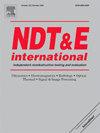Enhancement of laser-generated ultrasonic wavefield in noisy experimental environments using latent assimilation
IF 4.5
2区 材料科学
Q1 MATERIALS SCIENCE, CHARACTERIZATION & TESTING
引用次数: 0
Abstract
This study explores the fusion of models and data in dynamic systems for structural health monitoring, using Kalman filter-based estimations. For linear Gaussian state-space models, the Kalman filter is a low-complexity optimal solution that merges observation data with state vectors derived from dynamic process modeling. However, Kalman filtering struggles with high-dimensional systems due to the large matrix inversion required in the algorithm. To overcome this limitation, we propose using reduced-order modeling (ROM) through latent assimilation (LA) to refine ultrasonic wavefields affected by environmental noise. Specifically, we employ a convolutional autoencoder (CAE)-based dimensionality reduction approach. The CAE encodes physical space into a latent space, allowing data assimilation (DA), performed via the Kalman filter, to be executed efficiently. To capture the evolution of latent state-space vectors, as opposed to the trend in the literature, we used the Gated Recurrent Unit (GRU) for its advantage in terms of computational efficiency and training speed, due to its simpler architecture and fewer parameters. The filtered latent vectors are then decoded back into physical space via the CAE. This method is demonstrated on a laser-ultrasonic wavefield collected in a noisy environment, with results aligning with the study’s hypotheses. The proposed technique is therefore applicable to ultrasonic datasets acquired in an inhospitable environment.
利用潜在同化增强噪声实验环境中激光产生的超声波波场
本研究利用基于卡尔曼滤波的估计,探讨了结构健康监测动态系统中模型和数据的融合。对于线性高斯状态空间模型,卡尔曼滤波是一种低复杂度的最优解,它将观测数据与动态过程建模得出的状态向量合并在一起。然而,由于算法中需要大量的矩阵反演,卡尔曼滤波在高维系统中遇到了困难。为了克服这一限制,我们提出了通过潜在同化(LA)的降阶建模(ROM)来细化受环境噪声影响的超声波波场。具体来说,我们采用了一种基于卷积自编码器(CAE)的降维方法。CAE将物理空间编码为潜在空间,允许通过卡尔曼滤波器执行的数据同化(DA)有效地执行。为了捕捉潜在状态空间向量的演变,与文献中的趋势相反,我们使用了门控循环单元(GRU),因为它的结构更简单,参数更少,在计算效率和训练速度方面具有优势。然后通过CAE将过滤后的潜在向量解码回物理空间。该方法在噪声环境中采集的激光超声波场上进行了验证,结果与研究假设一致。因此,所提出的技术适用于在恶劣环境中获得的超声波数据集。
本文章由计算机程序翻译,如有差异,请以英文原文为准。
求助全文
约1分钟内获得全文
求助全文
来源期刊

Ndt & E International
工程技术-材料科学:表征与测试
CiteScore
7.20
自引率
9.50%
发文量
121
审稿时长
55 days
期刊介绍:
NDT&E international publishes peer-reviewed results of original research and development in all categories of the fields of nondestructive testing and evaluation including ultrasonics, electromagnetics, radiography, optical and thermal methods. In addition to traditional NDE topics, the emerging technology area of inspection of civil structures and materials is also emphasized. The journal publishes original papers on research and development of new inspection techniques and methods, as well as on novel and innovative applications of established methods. Papers on NDE sensors and their applications both for inspection and process control, as well as papers describing novel NDE systems for structural health monitoring and their performance in industrial settings are also considered. Other regular features include international news, new equipment and a calendar of forthcoming worldwide meetings. This journal is listed in Current Contents.
 求助内容:
求助内容: 应助结果提醒方式:
应助结果提醒方式:


